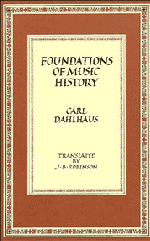Book contents
- Frontmatter
- Contents
- Translator's preface
- Foreword
- 1 Is history on the decline?
- 2 The significance of art: historical or aesthetic?
- 3 What is a fact of music history?
- 4 Does music history have a ‘subject’?
- 5 Historicism and tradition
- 6 Hermeneutics in history
- 7 The value-judgment: object or premise of history?
- 8 The ‘relative autonomy’ of music history
- 9 Thoughts on structural history
- 10 Problems in reception history
- Bibliography
- Index
9 - Thoughts on structural history
Published online by Cambridge University Press: 01 June 2011
- Frontmatter
- Contents
- Translator's preface
- Foreword
- 1 Is history on the decline?
- 2 The significance of art: historical or aesthetic?
- 3 What is a fact of music history?
- 4 Does music history have a ‘subject’?
- 5 Historicism and tradition
- 6 Hermeneutics in history
- 7 The value-judgment: object or premise of history?
- 8 The ‘relative autonomy’ of music history
- 9 Thoughts on structural history
- 10 Problems in reception history
- Bibliography
- Index
Summary
‘Structural history’ is a fashionable term. For several decades now historians have tended to depict or analyse historical structures, or ‘circumstances’ as they were called in the nineteenth century, instead of recounting events or sequences of events. The reasons for this are – as Thomas Kuhn maintained of practically all changes of ‘scientific paradigm’ – partly non-scientific in nature; indeed, the word ‘fashionable’ would not apply otherwise. To begin with, many historians have let themselves be browbeaten by the prestige of the exact, ‘nomothetic’ disciplines into adopting an analytical and discursive style to replace, or at least to augment, the epic style of traditional history, where readers were meant to sense the nearness of actual events. (Without necessarily being aware of it, these antitraditionalist historians address readers who are more likely to project themselves into an historical situation that was endured collectively than to identify with individual heroes towering above the mass of their contemporaries.) Furthermore, the ‘administrated world’, as Adorno loathingly called modern society, has experienced the intrusion of feelings of anonymity, of depersonalisation and conformism, which cast doubt on the viability that historicists once saw in individuality as a basic category of history. At all events, these feelings are sufficient cause for historians to root out half-hidden functional connections in earlier centuries as well and to put greater stress on them than on individual events and deeds.
- Type
- Chapter
- Information
- Foundations of Music History , pp. 129 - 150Publisher: Cambridge University PressPrint publication year: 1983

